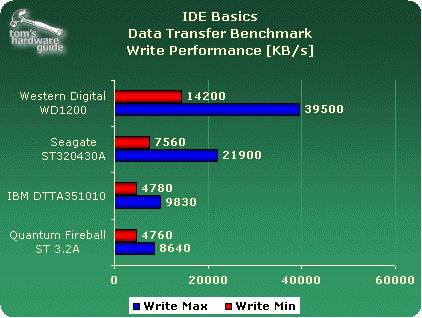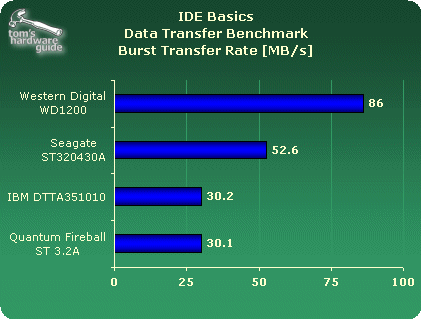IDE Training Course, Part 1: A Detailed Look at the Basics and Technology
Test Configuration
| Test System | |
|---|---|
| Processor | Intel Pentium 4, 2 GHz, 256 kB L2-Cache (Willamette) |
| Motherboard | Intel 845EBT,845E chipset |
| RAM | 256 MB DDR/PC2100, CL2Micron/Crucial |
| IDE controller | i845E UltraDMA/100 controller (ICH4) |
| Graphics card | ATI Radeon SDRAM, 32 MB |
| Network | 3COM 905TX PCI 100 Mbit |
| Operating systems | Windows XP Pro 5.10.2600 |
| Benchmarks and Measurements | |
| Office applications | ZD WinBench 99 - Business Disk Winmark 1.2 |
| High-end applications | ZD WinBench 99 - Highend Disk Winmark 1.2 |
| Performance test | ZD WinBench 99 - Disc Inspection TestHD Tach 2.61 |
| I/O performance | Intel I/O Meter |
| Drivers and Settings | |
| Graphics driver | 5.1.2001.0 (Windows XP standard) |
| IDE driver | Intel Application Accelerator 2.2 |
| DirectX version | 8.1 |
| Screen resolution | 1024x768, 16 bit, 85 Hz refresh |
Benchmarks
Data Transfer Performance


Those were the days! These days you can barely do anything with maximum transfer rates of some 8.6 MB/s (Quantum UltraDMA/33). The first truly remarkable improvement in performance was brought about by the first generation of IDE hard drives featuring 7,200 rpm and UltraDMA/66.
Burst Performance

This clearly shows what each interface has to offer. While the first two UltraDMA/33 drives had access times of some 30 MB/s, the maximum (reading from the hard drive's cache) jumped to over 50 MB/s with Seagate's Barracuda ATA (UltraDMA/66), and today's UltraDMA/100 hard drives feature an impressive 86 MB/s. This upper limit will soon be pushed significantly, with the introduction of Serial ATA.
Stay on the Cutting Edge
Join the experts who read Tom's Hardware for the inside track on enthusiast PC tech news — and have for over 25 years. We'll send breaking news and in-depth reviews of CPUs, GPUs, AI, maker hardware and more straight to your inbox.
Current page: Test Configuration
Prev Page Hardware Check: The Proper Cables Next Page Access Time TestMost Popular

